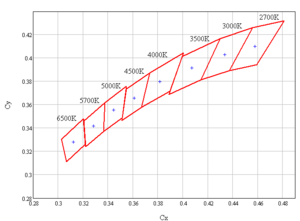ANSI White: Difference between revisions
No edit summary |
Remove mention of Lumileds since they don't use ANSI white; add Luminus since they do |
||
| Line 10: | Line 10: | ||
# 2700K | # 2700K | ||
This standard was adopted by | This standard was adopted by [[Cree]] to describe the tint of their LED products. They developed the concept further by dividing each ANSI quadrangle into four quadrants to get bins like 1A, 1B, 1C, and 1D being divisions of quadrangle 1 (6500K). Towards the cold end of the spectrum a non-ANSI quadrangle, quadrangle 0, was added. Tints lying outside of the ANSI standard, above and below quadrangles 0, 1, 2, 3, 4, and part of 5, are given names like 1R, 1S, 1T, and 1U. Cree subdivides regions 5, 6, 7, and 8 into even smaller subdivisions to get bins like 5A1, 5A2, 5A3, and 5A4. | ||
[[Luminus]] does something similar by subdividing the standard ANSI quadrangles and adding their own outside of those limits. | |||
[[File:Ansiwhite.jpg|thumb|left|400px|Chromaticity chart with ANSI quadrangles by CCT and Cree divisions and subdivisions]] <BR CLEAR="ALL"> | [[File:Ansiwhite.jpg|thumb|left|400px|Chromaticity chart with ANSI quadrangles by CCT and Cree divisions and subdivisions]] <BR CLEAR="ALL"> | ||
Revision as of 17:40, 5 January 2011

ANSI C78.377-2008 is a standard developed by the American National Standards Institute (ANSI), the American National Standard Lighting Group (ANSLG), and the National Electrical Manufacturers Association (NEMA) in 2008 to standardize the description of tints in LED's and Solid State Lighting. It is based on a similar standard developed for fluorescent lighting. It sets up 8 points with coordinates based on correlated color temperature (CCT), and offsets from each coordinate that describe quadrangles on the chromaticity chart as shown in the graphic to the right.
- 6500K
- 5700K (cool white)
- 5000K
- 4500K
- 4000K (neutral white)
- 3500K
- 3000K (warm white)
- 2700K
This standard was adopted by Cree to describe the tint of their LED products. They developed the concept further by dividing each ANSI quadrangle into four quadrants to get bins like 1A, 1B, 1C, and 1D being divisions of quadrangle 1 (6500K). Towards the cold end of the spectrum a non-ANSI quadrangle, quadrangle 0, was added. Tints lying outside of the ANSI standard, above and below quadrangles 0, 1, 2, 3, 4, and part of 5, are given names like 1R, 1S, 1T, and 1U. Cree subdivides regions 5, 6, 7, and 8 into even smaller subdivisions to get bins like 5A1, 5A2, 5A3, and 5A4.
Luminus does something similar by subdividing the standard ANSI quadrangles and adding their own outside of those limits.

Further reading
- NEMA website ANSI standard can be downloaded after registering for free.
- Wikipedia: Chromaticity
- Wikipedia: Color temperature